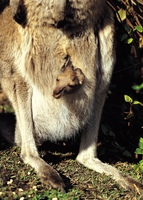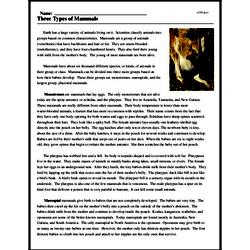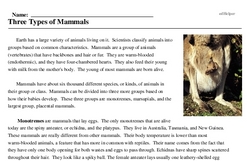Three Types of Mammals
Earth has a large variety of animals living on it. Scientists classify animals into groups based on common characteristics. Mammals are a group of animals (vertebrates) that have backbones and hair or fur. They are warm-blooded (endothermic), and they have four-chambered hearts. They also feed their young with milk from the mother's body. The young of most mammals are born alive.
Mammals have about six thousand different species, or kinds, of animals in their group or class. Mammals can be divided into three more groups based on how their babies develop. These three groups are monotremes, marsupials, and the largest group, placental mammals.
Monotremes are mammals that lay eggs. The only monotremes that are alive today are the spiny anteater, or echidna, and the platypus. They live in Australia, Tasmania, and New Guinea. These mammals are really different from other mammals. Their body temperature is lower than most warm-blooded animals, a feature that has more in common with reptiles. Their name comes from the fact that they have only one body opening for both wastes and eggs to pass through. Echidnas have sharp spines scattered throughout their hair. They look like a spiky ball. The female anteater lays usually one leathery-shelled egg directly into the pouch on her belly. The egg hatches after only ten or eleven days. The newborn baby is tiny, about the size of a dime. After the baby hatches, it stays in the pouch for several weeks and continues to develop. Babies are fed by their mother's milk that seeps out of pores on her skin. When the babies are six to eight weeks old, they grow spines that begin to irritate the mother anteater. She then scratches the baby out of her pouch.




